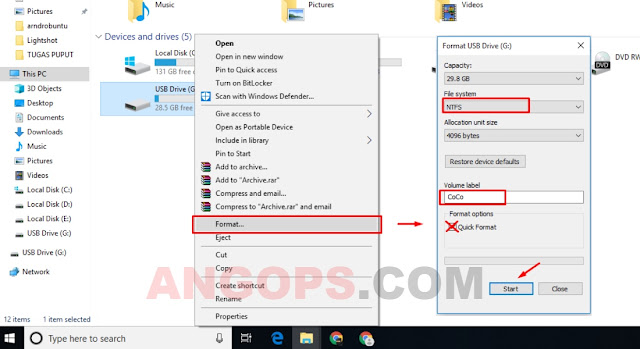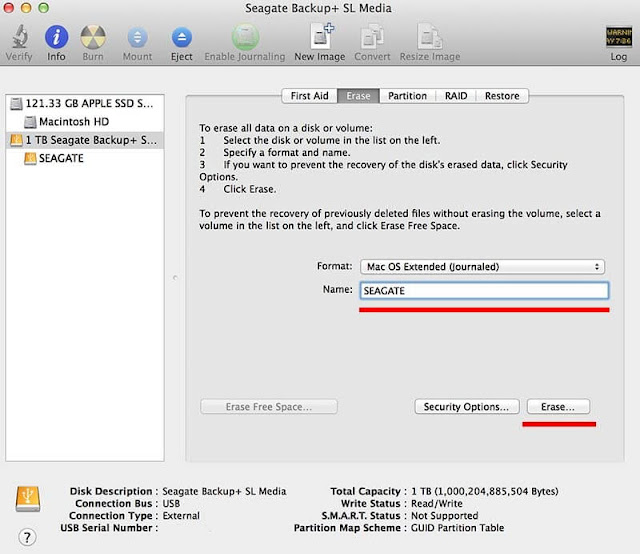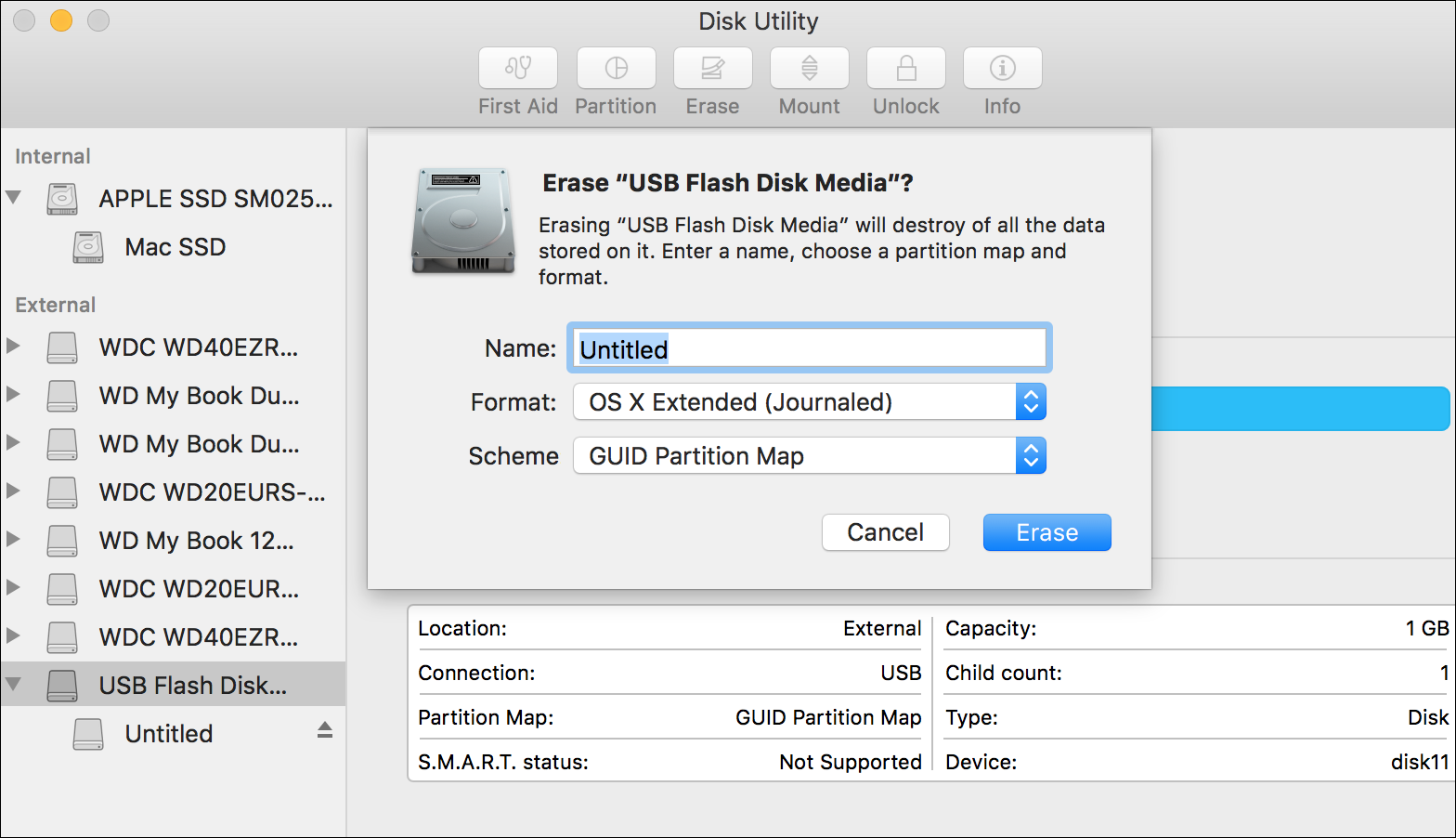Sistem operasi Mac berbeda dengan Windows dan Linux yang dapat membaca (read) dan menulis (write) hard disk external berformat NTFS. Sedangkan pada default-nya Mac OS hard disk type NTFS tidak akan terbaca serta digunakan pada Mac OS. Untuk dapat mengatasinya kita dapat menggunakan bantuan software pihak ketiga. Baca juga: Cara Mengubah dan Menampilkan Extensi File di. Choose Mac OS Extended (Journaled) from the Format pop-up menu and click the Apply button. In the sheet that appears click the Partition button and your flash drive will be formatted as a Mac OS X.
Format an External Disk or Flash Drive for Mac in Maverics Now type a new name for the Volume and select the format type as Mac OS Extended (Journaled). Now click the “Erase” button and confirm again on the next pop-up window to format the External Disk or a Flash Drive for Mac. Pertama, sambungkan flash disk yang ingin di format pada komputer atau laptop Mac yang kamu gunakan. Kalau flashdisk masih bisa dibuka dan ada data penting di dalamnya, sebaiknya dibackup terlebih dahulu di media penyimpanan lain. Insert the flash drive or hard drive you want to format for Windows compatibility. Go to the Applications folder on your Mac’s hard drive, then go to the Utilities folder, and launch Disk Utility. Select the drive you want to format. Warning: the following steps will delete any info you currently have on the drive.
Cara Format Flash Disk Di Mac
Dec 16, 2020 • Filed to: Solve Mac Problems • Proven solutions
There are lots of people who mistakenly think that the USB drives and hard drives format don’t really matter. But the reality is quite different. Whether it is a hard drive or USB or internal drive, Mac uses different format support. So, you can’t simply use the same drive with both Windows and Mac. As a result, you will need to format the hard drive for Mac. Using the Mac preferred file system is important otherwise the files will be of no use to you.
In this article, we are going to discuss how to format a hard drive for Mac and some related terms too.
Part 1. Situations When Formatting a Hard Drive on Mac:
Before you get deep, you must understand what is the drive formatting. Some people confuse the term with reformatting. Basically, formatting is the process of preparing the storage devices such as hard disk drive, solid-state drive, USB flash drive, or any other for initial use.
The basic operation is termed as low-level formatting which means erasing the existing data on the disk. But it leaves the track to recover the data using the recovery tool.
There is another term related to disk formatting and it is called reformatting. It is called high-level formatting as it is used to prepare the disk for different file system formats. It is usually done during the OS installation or adding a new disk. Reformatting is done to free the storage space from the previous content stored in it.
You can consider disk formatting in macOS in various circumstances. Whether your system has corrupted data, damaged software, impending system upgrade, storage is full, or it is running slow, formatting will fix a lot of issues. Take a look at the scenarios given below and you will be sure that disk formatting will help you.
- If you want to quickly erase all content from the drive permanently without leaving a trace of data on it.
- If you want to change the format of the disk such as PC format like FAT or exFAT to Mac format.
- If you see the message that the disk is not readable by Mac.
- If you want to resolve a disk issue that can’t be fixed by the Repair feature of Disk Utility.
- If the macOS installer can’t see the disk or unable to install it.
- In case the macOS installer says that the drive can’t be installed because it is a part of Apple RAID.
Under all these situations, formatting is most likely to fix your problems and you will be able to use the drive on Mac.
Part 2. How to Format a Hard Drive on Mac:
Formatting is a very simple procedure that is operated in a similar way for all sorts of storage media. So, whether you wish to format the internal hard drive, external drive, or a USB flash drive, the procedure is the same for all. Here is the step by step guide you need to follow to format the hard disk on Mac. Before you erase a disk, make sure that you have a backup of the files you want to keep.
Step 1: Connect the USB drive or external drive to Mac and launch the Disk Utility from Applications.
Step 2: From the left side panel, pick the volume or the drive that you want to format and switch to the Erase tab.
Step 3: As you click on the Erase button, you will see several fields in the section. Enter the given information-

- Name- Enter a name for the disk such as Macintosh HD/SSD/USB Drive or anything else you want.
- Format- You have to choose a Mac supported format from the list. The most recommended format is APFS or Mac OS Extended (Journaled). There are numerous other formats too which will be displayed in the drop-down menu. You can select any format as per your requirement.
- The scheme- If this option is available, then you should choose the GUID Partition Map from the option.
Step 4: After specifying the fields, click on the Erase button at the bottom of the window and Disk Utility will format the drive.
Once the formatting is complete, you can use the disk for a backup drive, sharing, time machine backup, or any other requirement. In case if the drive doesn’t appear in the Disk Utility interface, you will have to disconnect all the extra and non-essential devices connected to Mac. Make sure that the External drive is on and connected properly. Restart your Mac and then carry out the task.
Part 3. How to Perform Mac Data Recovery After Format:
There are situations when Mac users don’t get the chance to create a backup of their data and forced to format the hard drive. But you don’t need to panic. You can get your hands on Recoverit data recovery for Mac. If you have mistakenly formatted the data that you still need, Recoverit is the best chance you have to get the files back. It is a complete data recovery solution that is capable of recovering all kinds of files with wide format support of 1000+.
You can download the software from the official website and install it immediately on Mac. Once the setup is complete, follow the steps below to recover formatted drive files.
Step 1: Specify Location:
Run the program and specify a location from the main drive. If data is lost from an external drive or USB flash drive, then you’ll have to connect the drive with the system and then specify the location.

Click on the Start button to initiate the scanning process.
Step 2: Scan Results:

Depending on the data that is lost or deleted, scanning will take some time. As the process finishes, the files will be displayed on the screen according to their respective format.
You can decide whether you want to look for files according to file type or file path. You can also stop the scanning process in between if the results are displayed before the scanning finishes.
Step 3: Preview and Recover Formatted Data:
As soon as the data is displayed on the screen, you can have a preview of the files. Select as many files as you want and have a preview of the files. Tap on the Recover button to save the files on your system.
As you are retrieving the files, keep in mind not to save the files in the previous location. Depending on the amount of recovery, it will take a while and ultimately you’ll have your files back. If the normal scan doesn’t work for you, Recoverit also has a deep scan mode to look deeper for the deleted and lost files.
Part 4. Different Formats of Hard Drive for Mac:
Mac Hard drives have wide support for formats but there are two major formats that are preferably used by the Mac users. It also depends on the macOS version you are using. The key point to consider is that the drives formatted with the newer versions won’t be recognized by the older devices. So, when you are formatting a USB drive, it will be ideal to choose the right format which is Mac OS Extended.
The supported Mac formats for the drive are explained below:
APFS:
The APFS format is optimal for Solid State Drive such as flash drives. Hence, if you are formatting a flash drive, you should definitely choose the APFS format. Along with the flash drives, this format is also faster and more reliable for Mac hard drives.
Mac OS Extended:
Talking about Mac OS Extended, it is perfectly suitable if you want to use a drive for backup. The Time Machine feature of Mac still doesn’t have support for APFS disk. In case you select this format, Time Machine will prompt you to reformat the drive.
When you are formatting disk on Mac, keep some things in mind. Never ever change the inbuilt format of a Mac drive.
Part 5. Tips for Formatting a Hard Drive on Mac:
Even though formatting doesn’t seem like a big deal, still it can be very helpful. So, you must stay active and keep all things in mind. Here are some tips that might help you when you are about to format a Mac hard drive.
- Disk Utility in macOS Sierra and later chooses a compatible format for you automatically. But you should know the default format for your drive. It is advised not to change the default format of a Mac hard drive under any circumstances.
- You can check the format of a drive inside the Disk Utility Menu bar. Just click on the Get Info option and you’ll know the current format a drive is using to store files. Open the System information and select the storage. In the right-side panel, you will see the respective format for each volume on your Mac.
- If you want to erase your disk before you install the latest High Sierra on your Mac for the first time, then opt-out for the Mac OS Extended format. During the installation of OS, the macOS installer will automatically decide whether to use APFS or Mac OS Extended for the disk.
- You can also use the FAT32 format on Mac for USB drives if you wish to use it on both Mac and Windows. The FAT32 format can be read and written on both OS and hence it is the most versatile format for use.
- If you wish to transfer big files from Windows to Mac, you’ll still have an alternative, i.e. exFAT. This format doesn’t have a file limit but it can only be read on Mac OS X Snow Leopard or later.
So, before you pick out the format, look out for the advantages and the disadvantages of the formats to choose the optimal format for Mac. The Windows supported format is usually listed as an MS-DOS format in the list of formats.
Wrapping It Up:
As you can see, now you know how to format hard drive/ USB flash drive/ internal drive/external drive on Mac. So, from now on whenever someone is in need, you can help them. And formatting doesn’t always finish without complications. So, if you lost some important files while formatting the drive, you can use Recoverit data recovery software for Mac to restore them in the original condition. Recommend the software to your friends and family and let them know that there is a master tool for recovery for both Mac and Windows OS in the market.
What's Wrong with Mac
- Recover Your Mac
- Fix Your Mac
- Delete Your Mac
- Learn Mac Hacks
If you want to format a hard drive or USB flash drive on your computer, disk formatting tool is the best choice. In this article, we will introduce 5 disk formatting tools for Windows and Mac to help you securely format hard drive/USB flash drive or memory card on a PC or a Mac. Just read on.
Top 5 Disk Formatting Tool for Windows/Mac
When you format a hard drive, you may worry about two things: 1. whether the formatting process takes very long time to complete; 2 whether the formatting operation would cause damage or shorten the service life of the hard drive. Don't worry, the top 5 disk formatting tools bellow are 100% safe disk formatting tool for Windows or Mac OS. They will efficiently format hard drive or external device under Windows or Mac OS. And they will never cause any damage to your hard drive or shorten the service life of the hard drive/SSD/USB flash drive, etc.
No.1 disk formatting tool for Windows and Mac – Built-in Formatting tool
Both Windows and Mac OS offer built-in disk formatting tool. For Windows, it offers quick format feature when you right-click the hard drive on the computer. If you are using a Mac, you can run the built-in Disk Utility to quickly format a hard drive or external hard drive under Mac OS. However, the formatted data can be recovered by data recovery software.
No.2 disk formatting tool for Windows and Mac – AweEraser
AweEraser is a secure data eraser. It can help you format a hard drive and permanently erase all data on the hard drive, beyond the scope of data recovery. Two versions are available: AweEraser for Windows, AweEraser for Mac. Just free download it here:
If you are going to sell/donate or recycle your hard drive/storage media device, you can run AweEraser on a PC or Mac. Then use this tool 'Erase Hard Drive' to format and erase the hard drive/storage media. Once the hard drive is formatted by AweEraser, the data is permanently lost, can't be recovered by data recovery software.
Format Flash Disk Di Mac
No.3 disk formatting tool for Windows and Mac – Stellar Disk Wipe
This tool can help in formatting hard drive, USB flash drive, memory card and other storage media under Windows or Mac OS. This hard disk formatting software can help you format/wipe your entire hard drive in a single step. The software includes powerful as well as fast wiping algorithms that erase unwanted data from the hard drive permanently.
No.4 disk formatting tool for Windows and Mac – Super Eraser
Super Eraser is another data eraser for Windows/Mac. It also can help you format the hard drive and permanently erase data from the formatted hard drive. It also can selectively erase data from a hard drive or external device.
No.5 disk formatting tool for Windows and Mac – Paragon Disk Wiper
Paragon Disk Wipe allows you to create a bootable USB-flash drive or external hard drive that will help you to completely erase a whole hard disk, a separate partition or just clean free space. It is the reliable disk formatting tool for Windows/Mac. After formatting, the data will be permanently lost.
The top 5 disk formatting tools for Windows and Mac can help you securely format hard drive or external device under Windows/Mac OS. AweEraser is the outstanding one among the 5 disk formatting tools. It will securely format the hard drive and permanently erase the data. Then your hard drive is able to donated, resold, lent, or abandoned.